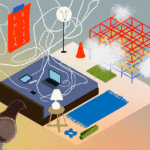Flashback to Cairo
Most mornings in Cairo started with a cup of tea and the quotidian sunrise muezzin call; it had become my daily ritual to sit in the hotel balcony and watch the scene unfold below. The city wore different looks throughout the day, and at dawn, the sun cast a glow on the calm roads. The empty 15th May Bridge that went over the meandering Nile River and the skyscrapers lining the banks of the wealthy Zamalek neighbourhood were shrouded in silence that was broken only by the azan.
It has been a year since I visited the buzzing capital of Egypt with my family of two moody children and a nonchalant husband. Those were the pre-pandemic days, when life had a different rhythm. The kids’ winter break had turned out to be the perfect time of year to soak up the pleasant December weather of the country that is part of the fertile crescent region and home to the world’s earliest human civilisation. I had read up and watched documentaries about Egypt’s rich pharaonic heritage, with its intriguing theories of the afterlife and the magical Nile. But, it was Cairo Time, the Arab-Canadian director Ruba Nadda’s 2009 award-winning film, that had provided a peek into the city’s cultural life even before I landed there. The movie is a love letter to this beguiling place in the African continent, and it lured me into visiting. While my trip to the city of a thousand minarets was made to experience and understand its culture and history, New York-based Juliette, the protagonist of Cairo Time (played by the sublime Patricia Clarkson), travelled there to holiday with her husband, a United Nations official working in Gaza.
She took her time getting comfortable, initially finding the city’s large population and teeming traffic overwhelming. But I felt entirely at home in the metropolis that, like India, bustles with people and carries a story in every street – such as this engaging anecdote about the hotel we checked into. Now called Cairo Marriott Hotel & Omar Khayyam Casino, the former Royal Palace Al Gezira was built in 1869 by the then ruler of Egypt, Khedive Ismail, as a guest residence during the Suez Canal inauguration celebrations. Famous historical personalities, including Empress Eugenie, wife of Emperor Napoleon III, have stayed in this neoclassical palace.
From the hotel’s balcony, I observed the 15th May Bridge come to life by 10 a.m. every morning as cars and buses moved at a snail’s pace, contributing to Cairo’s infamous traffic issues. Surprisingly, I rarely heard the Cairenes use their horns, something that’s so common with drivers back home. And in the distance, the sand-hued houses of Cairo’s not-so-affluent families. The Cairo Tower, one of Egypt’s modern monuments, with its pineapple-like facade, stood out at 187 metres and pierced the sky. Images of Mohamed Salah, the famous Egyptian football player, adorned city billboards. As the day progressed, Cairo’s skyline turned hazy, and by evening it was bejewelled with thousands of glowing lights.
I wondered how Juliette must have felt as she sat alone in her hotel balcony on that first day of her arrival, watching the ebb and flow of the city and taking in its many sights and sounds. Indeed, Cairo can be overwhelming for a lone woman. Her husband had not received her at the airport as he had been held up in Gaza. Instead, his former Egyptian security officer – the smoky-eyed Tareq, played by Alexander Siddig – accompanied her while she explored the city. The time they spent together gave rise to a relationship that was more than platonic but never consummated. Their reticent love is only depicted through flickering eyelids and deep, yearning looks.
As for me, the discovery of the city began with my family attending a Sufi show in the courtyard of the wikala of Sultan Qansuh al-Ghuri, a caravanserai built in the 16th century. Unlike the well-known, white-clad Turkish dervishes, the dancers in this troupe wore colourful vests and robes with weighted, ankle-length multicoloured skirts called Tanoura. Most tourists are unaware of this performance, but I was keen to experience the mystical form of Islam.
Accompanied by traditional music, the Tanoura (as the dance is also called) is a must-see when in Egypt, which is home to 77 Sufi orders. The performance that we watched started with slow, deliberate steps. The lead dancer played the sagat or Egyptian finger cymbals while others performed on the goblet drum, pharaonic lute and other percussion instruments. They seemed to be in a trance, connecting with the Almighty as they twirled rhythmically. Soon, the music gained in tempo. Hypnotically fast gestures replaced the sublime movements and reached a feverish, psychedelic pitch. The energy was palpable as the mesmerising dervishes moved fervently in circles, calling out to Allah with their eyes closed. I had never witnessed a Sufi show, and this unique experience gave me a sense of Egypt’s spiritual culture.
That night, still jet-lagged, we stepped into the dark and moody interiors of Abou El Sid, a restaurant famous for local delicacies. Patrons were busy smoking shisha as Egypt’s legendary vocalist Umm Kulthum’s throaty songs played in the background. The same contralto voice that had so impressed Juliette. On my first night in the country, I was introduced to the Egyptian tarab – a state of rapturous enchantment – thanks to the diva’s enthralling singing, even as I dug into the molokheya (a popular leafy vegetable) served with chicken and rice.
The next morning, 50-year-old Marwa Elessamy, a local Egyptologist, greeted us in the hotel lobby. I was looking forward to the day’s outing and unravelling some of Cairo’s little-known secrets. I had always associated Egypt with its dominant Islamic faith, but I learned that Christianity has long been existing in the country, from as early as the first century AD, and it saw the rise of a new branch of the faith called the Coptic Orthodox Church. The Copts, as they are known, are said to be descendants of ancient Egyptians. Elessamy approximates that about 20 per cent of the population in Egypt are Copts. I walked through the narrow streets of Coptic Cairo (the oldest part of the city, with settlements dating back to the 6th century) and climbed the stairs of the Hanging Church with bell towers that resembled Noah’s Ark. Built on top of the gates of an old Roman fortress, the church is home to many religious icons. But my real interest lay in the nearby Church of St Sergius, Cairo’s oldest church. It is believed that the cavern on its grounds was home to the Holy Family for three months during their escape from King Herod, before it became a church in the Apostolic Age. Elessamy also took us to the Ben Ezra Synagogue to give us a glimpse of the once-thriving Jewish community of multifaith Cairo.
At the Historic Cairo quarters, a UNESCO World Cultural Heritage site, we walked past the Sayyidna-al-Hussein. This mosque is considered one of the most sacred Islamic sites because it is thought to be the burial place of the head of Husayn ibn Ali, the grandson of Prophet Mohammed. Elessamy then led us through the noisy, crowded lanes of Cairo’s medieval market, Khan el-Khalili. It is a caravanserai supposedly built during the Mamluk period, and its vendors greeted us with, “India – Maharaja! Welcome to Egypt!” With goods of every kind under the sun on display – pharaonic souvenirs, Egyptian garments, incense, heady perfumes, spices, carpets, handicrafts – it was like walking through the set of an Arabian Nights production.
I could not help wondering if it was through these labyrinthine alleys that Juliette had walked with Tareq during her city escapades.
After some shopping, we headed to the historic El Fishawy cafe on Elessamy’s recommendation. Tucked away in one of the alleys of the market, the cafe is more than two centuries old and used to be frequented by Egyptian artists, writers and musicians. The famed Egyptian Nobel laureate Naguib Mahfouz was apparently one of its regular patrons. “These cafes are men-only. It’s only when I accompany tourists that I get to visit these places. I love these social joints,” said Elessamy in a passive tone. Though the Western-bred Juliette had been surprised by the absence of women in cafes, smoking with men, drinking coffee and playing chess, her experience as shown in Cairo Time (not to mention India’s own patriarchal social norms) had prepared me for my encounter with Egypt’s segregated society. At the 24×7 El Fishawy, I ordered Karkade (the national drink), a tea made by steeping the petals of the hibiscus flower, which can be enjoyed either hot or cold. While my husband and Elessamy relished the mint tea, cold karkade soon became my favourite drink during our stay in this warm country.
I was slowly getting the hang of Cairo’s culture and history, but we were yet to visit the pyramids — the reason that most visitors flock to Cairo. We had planned to visit the Giza Governorate on the last day of our stay. “The Great Pyramid of Giza is the tomb of King Khufu. You can walk into the pyramid; it’s a different experience,” said Elessamy. While Juliette never entered the pyramid and had been happy to sit beside Tareq on one of its 2.3 million stone blocks, each weighing more than two tons, we decided to explore its interiors. The kids were kicked by the idea of venturing into the megalithic site, said to be 4500 years old. As I trudged into the structure huffing and puffing, it was a piece of cake for them. While various debatable controversies surround the existence of the pyramids, I like to think of it as a spiritual granary with electromagnetic energy, a sound healing structure, or a religious centre for ceremonies.
That night, we decided to explore Cairo on foot. It was New Year’s Eve, and the city held a festive look. Zamalek was waking up to its nightlife. High-end hotels like the Sheraton Cairo Hotel & Casino and Cairo Marriott Hotel & Omar Khayyam Casino had many events lined up to rope in the New Year with music and dance. We walked on the Qasr El Nil bridge and headed towards Cairo’s iconic Tahrir Square. Youngsters were busy taking pictures with DSLR cameras and ring lights, a couple was getting cosy and a coachman tempted tourists with a horse carriage ride. Decked-up floating restaurants cruised on the Nile. Cairenes youth sat outside crammed restaurants enjoying dinner al fresco with shisha, and an old man tried to sell us a room in a “decent” hotel. There was too much happening all around us, and I was trying to absorb everything in a very short time.
Egypt was our last family vacation as the pandemic broke out soon after, and my wandering mind often goes back to Cairo’s mesmerising streets and cafes where socialising is the norm. I had found it to be endlessly captivating with its traditional heart and modern outlook; I, too, had fallen in love by the end of my trip. But like Juliette’s wistful romance with Tareq, travelling back there remains a distant dream for now.
Related posts from Verve:
Verve Trending
Sorry. No data so far.
us on Facebook to stay updated with the latest trends













